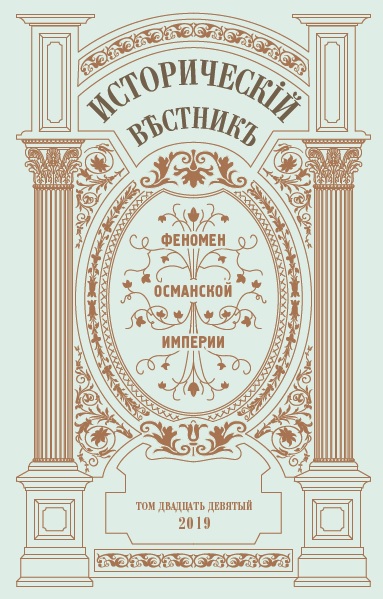
Джейн Хэтвей Евнухи в Османской империи
DOI: 10.35549/HR.2019.2019.47854Джейн Хэтвей Евнухи в Османской империи // Исторический вестник. 2019. Т. ХXIХ. С. 88—103.
Аннотация
Статья рассматривает вопрос о привлечении на службу евнухов в Османской империи. После общего обзора роли придворных евнухов в глобальном историческом контексте, исследование обращается к первым евнухам на османской службе, которые вероятно были византийскими военнопленными. К началу XV в. восточно-африканские евнухи гарема стали важной фракцией среди дворцовых евнухов; в статье рассматривается методика их отбора и кастрации. Строительство дворца Топкапы в недавно завоеванном Константинополе — в 50-х гг. XV в. — положило начало дихотомии между африканскими евнухами Гарема и белыми евнухами Третьего Двора. Не менее важным рубежом становится и конец XVI в., когда старший евнух Гарема принял на себя обязанности по управлению имперскими благотворительными пожертвованиями в Мекку и Медину, что сделало этого сановника одной из самых могущественных фигур империи. К концу XVII в. низложенные главные евнухи Гарема часто принимали командование над евнухами, охранявшими гробницу Пророка Мухаммеда в Медине. Влияние дворцовых евнухов оказывается ослабленным в XVIII столетии, по мере того как великий визирь получал все большую власть над управлением империи. Реформы XIX столетия нанесли решающий удар по власти евнухов Гарема, которая полностью сошла на нет при расформировании его младотурками в 1909 г.
Ключевые слова: евнухи, османы, Африка, кастрация, Топкапы, Медина.
***
Jane Hathaway. Eunuchs in the Ottoman Empire [Evnuhi v Osmanskoj imperii]. Istoricheskij vestnik / Historical Reporter. Vol. 29. 2019. P. 88—103.
Abstract
This article surveys the employment of eunuchs in the Ottoman Empire. After placing the use of court eunuchs in a global historical context, the study turns to the earliest eunuchs in Ottoman employ, who were probably Byzantine prisoners of war. By the early fifteenth century, East African harem eunuchs had become an important element of the palace eunuch population, and the article discusses their procurement and castration.
The construction of Topkapı Palace in newly-conquered Constantinople during the 1450s laid the ground for the dichotomy between African harem eunuchs and white Third Court eunuchs. An equally important watershed occurred in the late sixteenth century, when the Chief Harem Eunuch assumed the supervision of the imperial pious endowments for Mecca and Medina, making him one of the most powerful figures in the empire. By the late seventeenth century, deposed Chief Harem Eunuchs often commanded the eunuchs who guarded the Prophet Muhammad’s tomb in Medina.
The influence of all palace eunuchs decreased during the eighteenth century, as the grand vizier acquired ever more control over the empire’s administration. Nineteenth-century reforms dealt a permanent blow to the harem eunuchs’ authority, which ended entirely when the Young Turks disbanded the harem in 1909.
Key words: eunuchs, Ottoman, Africa, castration, Topkapı, Medina.
***
References
- Aktepe M.M. Patrona İsyanı, 1730. Istanbul: Edebiyat Fakultesi Basımevi, 1958.
- Ayalon D. Eunuchs, Caliphs, and Sultans: A Study in Power Relationships. Jerusalem: The Magnes Press, the Hebrew University, 1999, P. 304-315.
- Barbir K.K., Ottoman Rule in Damascus, 1700-1758. Princeton: Princeton University Press, 1980, P. 30, 178; [36] Uzuncarşılı, Saray Teşkilatı, 341-46.
- Burckhardt J.L. Travels in Nubia .New York: AMS Press, 1978, P. 294-95.
- Celebi E. Seyahatname, vol. 10// eds. Seyit Ali Kahraman, Yucel Dağlı, and Robert Dankoff. Istanbul: Yapı Kredi Yayınları, 2007, P. 205.
- Ertuğ H.F. Musahib-i Sani-i Hazret-i Șehr-yari Nadir Ağa’nın Hatiratı — II, Toplumsal Tarih 50. February 1998. P. 8.
- Guler M. Osmanlı Devlet’inde Haremeyn Vakıfları (XVI.-XVII. Yuzyıllar). Istanbul: Tarih ve Tabiat Vakfı, 2002, P. 213-215.
- Hathaway J. The Politics of Households in Ottoman Egypt: The Rise of the Qazdağlıs. Cambridge: Cambridge University Press, 1997, P. 140.
- Hathaway J. The Chief Eunuch of the Ottoman Harem: From African Slave to Power-Broker. Cambridge: Cambridge University Press, 2018, P. 14-279.
- Hathaway J.The Arab Lands under Ottoman Rule, 1516-1800. Harlow, Essex: Pearson Longman, 2008, P. 62-67, 89-90.
- Herodotus The Persian Wars, trans. George Rawlinson. New York: The Modern Library, 1942, P. 637
- Holt P.M. The Sudan of the Three Niles: The Funj Chronicles, 910-1288/1504-1871. Leiden: Brill, 1999.
- Lowry H.W. The Nature of the Early Ottoman State. Albany, NY: State University of New York Press, 2003, P. 75-77.
- McCullagh F. The Fall of Abd-ul-Hamid. London: Methuen and Co., Ltd., 1910, P. 53-56, 132, 251.
- Muhammad ibn Abdullah ibn Battuta Rihla Ibn Battuta. Beirut: Dar Sadr, Dar Bayrut, 1964,P. 301-302.
- Necipoğlu G. Architecture, Ceremonial, and Power: The Topkapı Palace in the Fifteenth and Sixteenth Centuries. New York: Architectural History Foundation; Cambridge, MA: M.I.T. Press, 1991, P. 159-173.
- Ozcan A. Turkiye Diyanet Vakfı İslam Ansiklopedisi. Istanbul: Turkiye Diyanet Vakfı Araştırmaları Merkezi, 1988-2013, vol. 27, P. 81-84.
- Patterson O. Slavery and Social Death: A Comparative Study. Cambridge, MA: Harvard University Press, 1982, P. 320.
- Pedani M.P. Safiye’s Household and Venetian Diplomacy. Turcica 32 2000, P. 14-22.
- Peirce L. The Imperial Harem: Women and Sovereignty in the Ottoman Empire. Oxford: Oxford University Press, 1993, P. 62-63, 97-112.
- Penzer N.M. The Harem: An Account of the Institution as It Existed in the Palace of the Turkish Sultans, with a History of the Grand Seraglio from Its Foundation. Philadelphia: J.P. Lippincott, 1936; 2nd ed. London: Spring Books, 1965, P. 132, 191-192.
- Shaun E. Marmon, Eunuchs and Sacred Boundaries in Islamic Society. Oxford: Oxford University Press, 1995, P. 31-77.
- Tosyavizade Rifat Osman Edirne Rehnuması. Istanbul: Printed by Acar Matbaacılık ve Ambalaj Sanayii A.Ş., for Ratip Kazancıgil, 1994, P. 87-88.
- U.S. National Archives, United States Department of State, Papers Relating to Internal Affairs of Turkey, 1910-29, 867.9111/226: Review of the Turkish Press for 28 June-11 July 1928.
- Uzuncarşılı I.H. Osmanlı Devletinin Saray Teşkilatı. Ankara: Turk Tarih Kurumu, 1945; reprinted 1984, 1988, P. 340-42, 354-57.
- White C. Three Years in Constantinople, or, Domestic Manners of the Turks in 1844, 2nd.. London: Henry Colburn, 1846, vol. 1, P. 246; vol. 2, P. 352, 360.
